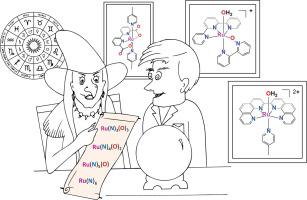Coordination Chemistry Reviews ( IF 20.3 ) Pub Date : 2021-10-12 , DOI: 10.1016/j.ccr.2021.214256 Abolfazl Ghaderian 1 , Samrana Kazim 1, 2 , Mohammad Khaja Nazeeruddin 3 , Shahzada Ahmad 1, 2

|
Energy conversion through sustainable means is essential to counter global warming and an urgent solution through a multidisciplinary approach is required. The temperature change stems from the emission of greenhouse gases largely contributed by burning fossil fuels; thus, its replacement with a clean, cheap, and sustainable energy source is paramount. Water is one of the integral sources and is potentially attractive to produce hydrogen (H2) gas to substitute fossil fuels. In this respect, molecular ruthenium complexes are by far the best molecular water oxidation catalysts (WOCs) to produce proton (H+) as a source for H2 gas production and molecular oxygen (O2) as a clean by-product. Here, we have made an insightful chronology of the ruthenium-based water oxidation catalysts (RWOCs) and quantify and classified the activation and deactivation pathways in chemical and electrochemical water oxidation reactions (WORs). In this insightful chronology, RWOCs are classified into three main groups, including Ru(N)6, Ru(N)5(O), and Ru(N)4(O)2 which the last group is the most robust and powerful WOCs. However, still, there is ∼200 mV overpotential for the Ru(N)4(O)2 group of complexes which is one of the current challenges in WOR. Based on the experimental data collected over the last four decades and extracted from these three categories, we suggest a new family of RWOCs that can be the workhorse of RWOCs with very low overpotential. Moreover, the lesson learned from RWOCs has been applied to redesign metal-based WOCs. Such insights provide unparalleled and practical information to produce the WOCs with various metals with high activity and durability that can be employed to cap global warming.
中文翻译:

设计下一代分子水氧化催化剂的战略因素:钌配合物的经验教训
通过可持续方式进行能源转换对于应对全球变暖至关重要,需要通过多学科方法紧急解决。温度变化源于主要由燃烧化石燃料造成的温室气体排放;因此,用清洁、廉价和可持续的能源替代它至关重要。水是不可或缺的来源之一,并且对生产氢气 (H 2 ) 以替代化石燃料具有潜在吸引力。在这方面,分子钌配合物是迄今为止产生质子 (H + ) 作为 H 2 气体产生和分子氧 (O 2) 作为清洁的副产品。在这里,我们对钌基水氧化催化剂 (RWOC) 进行了深入的年表分析,并对化学和电化学水氧化反应 (WOR) 中的活化和失活途径进行了量化和分类。在这个富有洞察力的年表中,RWOC 分为三个主要组,包括 Ru(N) 6、Ru(N) 5 (O) 和 Ru(N) 4 (O) 2,最后一组是最强大和最强大的 WOC . 然而,Ru(N) 4 (O) 2仍然有 ∼200 mV 的过电位一组复合物,这是 WOR 当前面临的挑战之一。根据过去四年收集并从这三个类别中提取的实验数据,我们建议了一个新的 RWOC 家族,它可以成为具有极低过电位的 RWOC 的主力。此外,从 RWOC 中吸取的经验教训已应用于重新设计金属基 WOC。这些见解提供了无与伦比的实用信息,以生产具有高活性和耐用性的各种金属的 WOC,可用于控制全球变暖。











































 京公网安备 11010802027423号
京公网安备 11010802027423号